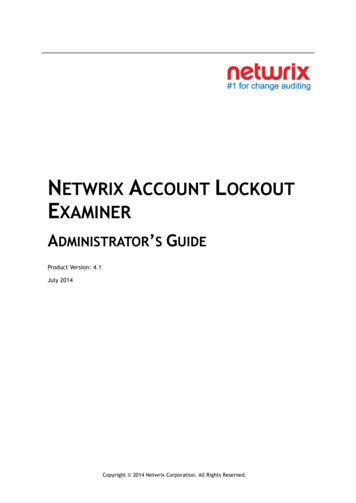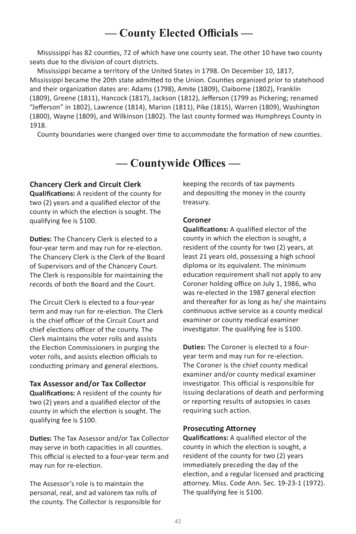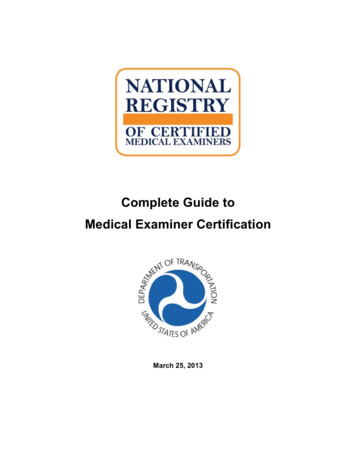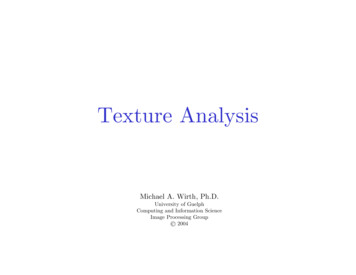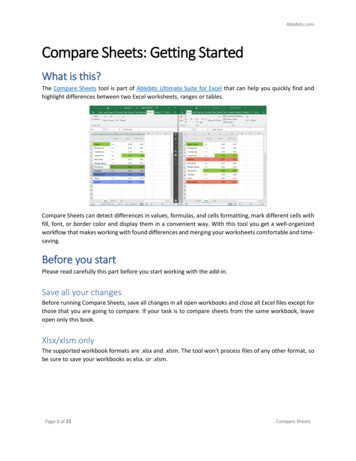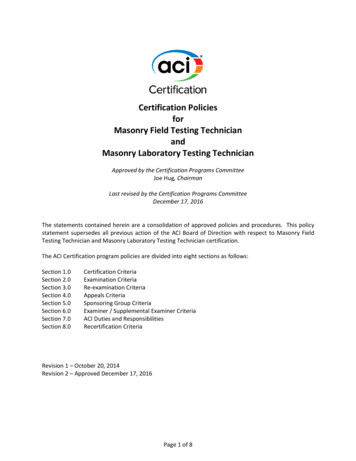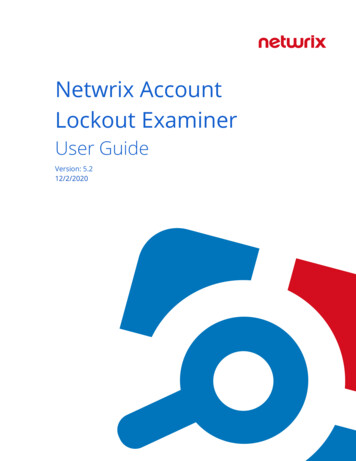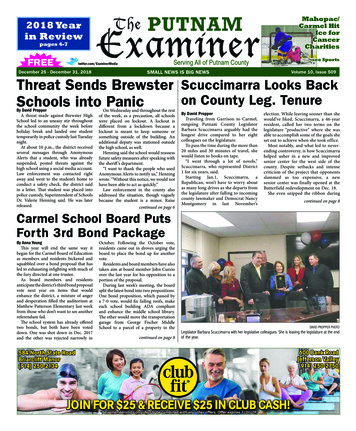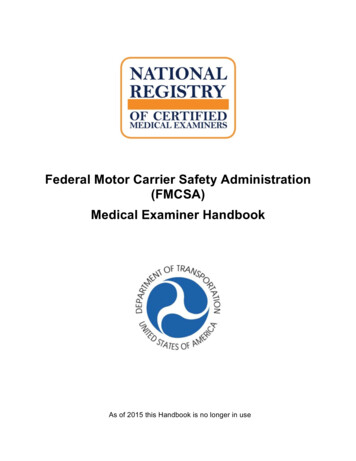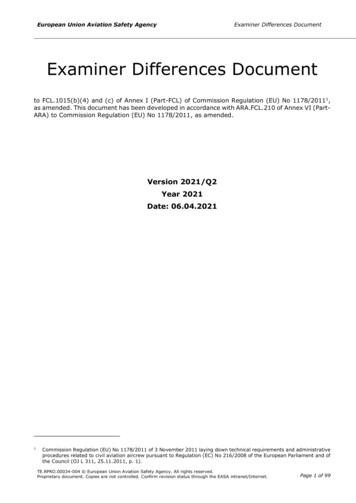
Transcription
European Union Aviation Safety AgencyExaminer Differences DocumentExaminer Differences Documentto FCL.1015(b)(4) and (c) of Annex I (Part-FCL) of Commission Regulation (EU) No 1178/20111,as amended. This document has been developed in accordance with ARA.FCL.210 of Annex VI (PartARA) to Commission Regulation (EU) No 1178/2011, as amended.Version 2021/Q2Year 2021Date: 06.04.20211Commission Regulation (EU) No 1178/2011 of 3 November 2011 laying down technical requirements and administrativeprocedures related to civil aviation aircrew pursuant to Regulation (EC) No 216/2008 of the European Parliament and ofthe Council (OJ L 311, 25.11.2011, p. 1).TE.RPRO.00034-004 European Union Aviation Safety Agency. All rights reserved.Proprietary document. Copies are not controlled. Confirm revision status through the EASA intranet/Internet.Page 1 of 99
European Union Aviation Safety AgencyExaminer Differences DocumentDisclaimerThe European Union Aviation Safety Agency (‘EASA’) maintains this document based on theinformation notified to it by the competent authorities of the Member States (‘CAs’), for purelyinformation purposes, as established under ARA.FCL.210. The content may be subject to changesat any time without prior notice.This material is:— fully based on information received from the CAs. Consequently it should not berelied upon as a statement, as any form of warranty, representation, undertaking,contractual, or other commitment binding in law upon EASA;— for information purposes only. All information provided is of a general nature only andis not intended to address the specific circumstances of any particular case, individual orentity. It may under no circumstances substitute or be represented as an official positionof EASA. If at any time there is a conflict or discrepancy between the information providedin this document and information given by the CAs that originated it or an official positionof EASA, the latter prevails.— not necessarily comprehensive, complete, accurate or up to date. All informationprovided in this document is originating from the CAs. It is provided here without warrantyof any kind, whether express, implied, statutory or otherwise especially as to its quality,reliability, currency, accuracy or fitness for purpose.— not professional advice, or any form of assessment, judgement or acceptanceby EASA.Despite every effort to ensure the accuracy of the information provided, it may contain occasionalinadvertent inaccuracies or typographical errors. Any error brought to the attention ofFCLexaminers@easa.europa.eu will be promptly corrected.To the maximum extent permitted by law, EASA is not liable for any loss or damage arising fromthe use of this information. EASA shall not be liable for any kind of damages or other claims ordemands incurred as a result of incorrect, insufficient or invalid data, or arising out of or inconnection with the use, copying, or display of the content, to the extent permitted by Europeanand National laws.This disclaimer is not intended to limit the liability of EASA in contravention of any requirementslaid down in applicable national law or to exclude its liability for matters which may not beexcluded under that law.TE.RPRO.00034-004 European Union Aviation Safety Agency. All rights reserved.Proprietary document. Copies are not controlled. Confirm revision status through the EASA intranet/Internet.Page 2 of 99
European Union Aviation Safety AgencyExaminer Differences DocumentCONTENTS1.REVISION TABLE . 42. GENERAL . 52.1. Introduction . 52.1.1.Purpose of the Examiner Differences Document . 52.1.2.Skill test or Proficiency check form declaration requirement . 52.1.3.Safety criteria in the territory of an EASA Member State . 52.2. Liability and accident insurance . 52.3. Personal data protection . 62.4. National administrative procedures . 62.4.1 Information before a skill test . 72.4.2 Information after a skill test, proficiency check or assessment of competence . 73. EASA Member States national procedures . 83.1. AUSTRIA . 93.2. BELGIUM .113.3. BULGARIA .153.4. CROATIA .183.5. CYPRUS .203.6. CZECH REPUBLIC .233.7. DENMARK .253.8. ESTONIA .283.9. FINLAND .303.10. FRANCE .333.11. GERMANY .373.12. GREECE .403.13. HUNGARY .423.14. ICELAND .463.15. IRELAND .493.16. ITALY.513.17. LIECHTENSTEIN .543.18. LATVIA .553.19. LITHUANIA .583.20. LUXEMBOURG .603.21. MALTA .623.22. NETHERLANDS .653.23. NORWAY .693.24. POLAND .723.25. PORTUGAL .743.26. ROMANIA .773.27. SLOVAKIA .803.28. SLOVENIA .823.29. SPAIN .853.30. SWEDEN .893.31. SWITZERLAND .924.EASA Member States safety criteria . 955.Links to Part-FCL national forms . 96TE.RPRO.00034-004 European Union Aviation Safety Agency. All rights reserved.Proprietary document. Copies are not controlled. Confirm revision status through the EASA intranet/Internet.Page 3 of 99
Examiner Differences DocumentEuropean Union Aviation Safety Agency1.REVISION TABLEChanges since last 4555569733 - 3623 – 24,9660-61 / 9770262728-2940-4149-50, 95, 979974-76FinlandHungaryLatviaLatviaLatviaFranceThe GreeceIrelandSwedenPortugalType of AmendmentText amended Restrictions on licenceendorsementsLink updatedText and links amendedInstructors rating endorsement not permitted.Links updatedLinks to Part-FCL national forms updatedText amended, Links updatedText amended and links updatedLinks updated§4.3.3 deletedText amendedText amendedName of organisation and contact details updatedText amendedText amendedNew linksNew linksNote: Changes are marked with red font in the body text.TE.RPRO.00034-003 European Union Aviation Safety Agency. All rights reserved.Proprietary document. Copies are not controlled. Confirm revision status through the EASA intranet/Internet.Page 4 of 99
Examiner Differences DocumentEuropean Union Aviation Safety Agency2.GENERAL2.1.Introduction2.1.1. Purpose of the Examiner Differences DocumentThis document has been developed in accordance with the provisions contained inARA.FCL.2102. In accordance with FCL.1015(b)(4) and (c), this document contains the latestavailable information on the relevant national administrative procedures, requirements forprotection of personal data, liability, accident insurance and fees for each EASA Member State(MS) for which the competent authority is not the same that issued the examiner’s certificate.It is intented for use by examiners with a Part-FCL examiner certificate conducting a test,check or assessment of competence on a Part-FCL licence holder whose licence was issued bya competent authority (CA) other than their own.This document is not meant to be used by examiners with examiner certificates or authorisationsissued by third countries other than the EASA MSs.This section should be carefully studied. Section 3 contains the national administrativeprocedures applicable to each EASA MS. These should be reviewed and applied when conductinga skill test, proficiency check or assessment of competence on a respective MS licence holder.Furthermore, any additional MS-specific requirements in addition to those specified in thissection, i.e. liability, accident insurance, and personal data protection related information, shouldalso be reviewed and taken into account by the examiner as appropriate.2.1.2. Skill test or Proficiency check form declaration requirementIn accordance with FCL.1030(b)(3)(iv), a MS skill test, proficiency check or assessment ofcompetence form requires a declaration by the examiner that he/she has reviewed and appliedthe MS-specific administrative procedures in case the applicant’s licencing authority is not thesame as the one that issued the examiner’s certificate.The skill test, proficiency check or assessment of competence forms of a MS used by examinerswho have been certified by another competent authority should contain the following declaration:‘I hereby declare that I, [name examiner], have reviewed and applied the relevant nationalprocedures and requirements of the applicant’s competent authority contained in version [insertdocument version, i.e. 01-2014] of the Examiner Differences Document. [enter date &signature]’Please ensure that you enter the relevant details and sign the declaration accordingly each timeyou conduct a test, check or assessment of competence.’2.1.3. Safety criteria in the territory of an EASA Member StateIn accordance with ARA.FCL.210(c), MSs may require an examiner to observe certain safetycriteria applicable to their territory when conducting a skill test or proficiency check on anaircraft. Section 3 of this document specifies whether such safety criteria will need to be observedand how to gain access to the relevant criteria. Section 4 of this document also contains a list ofall MSs with instructions on how to obtain the applicable safety criteria.2.2.Liability and accident insuranceIn general, the CA of an EASA MS does not provide liability or accident insurance during theconduct of skill tests, proficiency checks or assessment of competence. It is therefore theARA.FCL.210 Information for examiners(a) The competent authority shall notify the Agency of the national administrative procedures,requirements for protection of personal data, liability, accident insurance and fees applicable in itsterritory, which shall be used by examiners when conducting skill tests, proficiency checks orassessments of competence of an applicant for which the competent authority is not the same thatissued the examiner’s certificate.2TE.RPRO.00034-003 European Union Aviation Safety Agency. All rights reserved.Proprietary document. Copies are not controlled. Confirm revision status through the EASA intranet/Internet.Page 5 of 99
Examiner Differences DocumentEuropean Union Aviation Safety Agencyresponsibility of the examiner to ensure that he/she is adequately insured against incident,accident or liability issues.Furthermore, the examiner is fully responsible for the safety during the skill test, proficiencycheck or assessment of competence, either in an flight simulation training device (FSTD) or whenacting as pilot-in-command (PIC) in an aircraft. There are two principal types of risk againstwhich an examiner should consider insuring himself/herself. First, the direct involvement duringflying tests might lead to an accident and a claim for damages for loss or injury ensuing as aresult of the accident. Secondly, professional indemnity, for example a claim made against theexaminer by an applicant for an inadequate examination, or breach of contract. Examiners areadvised to seek professional advice concerning appropriate insurance covering their activities ascertified examiners.An aircraft operator must have third-party liability insurance, as required by Regulation (EC)No 785/20043 on insurance requirements for air carriers and aircraft operators. Such insurancemay cover an examiner for personal liability in case of accident; however, an examiner shouldalways verify this carefully with the operator if he/she intends to rely on this insurance.Note: This general statement on liability and accident ansurance has been agreed upon by theMSs and is based on the input received from the MSs. Any relevant differences to this generalstatement in a particular MS will be specified in section 3 of this document as applicable to theCA in the respective MS.2.3. Personal data protectionGeneral Data Protection Regulation (‘GDPR’) 4As of 25 May 2018 the Regulation (EU) 2016/6791, the European Union’s ('EU') new GeneralData Protection Regulation (‘GDPR’) which regulates the processing by an individual, a companyor an organisation of personal data relating to individuals in the EU, becomes applicable.This means that the persons or legal entities using the Examiner Differences Document shallcomply with the new GDPR.The GDPR aims to protect the rights and freedoms of persons with respect to the processing ofpersonal data by laying down guidelines determining when this processing is lawful.In general, skill test, proficiency check and assessment of competence forms and any otherpersonal information may only be passed to the examiner’s CA, the applicant’s CA as required,to the applicant and, if applicable, to the applicant’s organisation with his/her prior consent.No information shall be passed to others.Note: This general statement on personal data protection has been agreed upon by the MSs andbased on the input received from the MSs. Any relevant differences to this general statement ina particular MS will be specified in Section 3 of this document as applicable to the CA in therespective MS.2.4. National administrative proceduresSection 3 of this document contains the specific administrative procedures provided by the CAof each EASA MS.Please review the respective procedures and requirements carefully as non-compliance maylead to application processing delays and possibly render a completed skill test, proficiencycheck or assessment of competence invalid.Regulation (EC) No 785/2004 of the European Parliament and of the Council of 21 April 2004 on insurancerequirements for air carriers and aircraft operators (OJ L 138, 30.4.2004, p. eform-eu-dataprotection-rules en3TE.RPRO.00034-003 European Union Aviation Safety Agency. All rights reserved.Proprietary document. Copies are not controlled. Confirm revision status through the EASA intranet/Internet.Page 6 of 99
Examiner Differences DocumentEuropean Union Aviation Safety Agency2.4.1 Information before a skill test1.Examiner details: Examiner's (complete)name and initials Examiner’s certificatenumber Country of examinercertification Contact details: mobilephone number, e-mailaddress2.Candidate details: Candidate’s name andinitials Candidate’s licence number3.Skill test details: Type of skill test Type of aircraft Specify skill test in aircraftor FSTD Name of FSTD operator FSTD approval certificate Aircraft registration Date and time PlaceNote: Please ensure that you send good quality scanned pdf copies when sending theinformation via e-mail.2.4.2 Information after a skill test, proficiency check or assessment of competenceAfter completion of a skill test, proficiency check or assessment of competence, the examinerreport shall include:1. A skill test or proficiency check or assessment of competence form,2. A flight test schedule (if applicable).3. Copy of the statement of the approved training organisation (ATO) which confirms therequired training has been completed (if applicable).4. Copy of FSTD approval certificate (if applicable).5. Copy of the examiner's licence. (if applicable).6. Copy of the examiner's certificate.7. Copy of the examiner’s medical certificate. (if applicable).8. Copy of endorsed licence (if entry on licence by examiner).Note: Please ensure that you send good quality scanned pdf copies when sending theinformation via e-mail.TE.RPRO.00034-003 European Union Aviation Safety Agency. All rights reserved.Proprietary document. Copies are not controlled. Confirm revision status through the EASA intranet/Internet.Page 7 of 99
Examiner Differences DocumentEuropean Union Aviation Safety Agency3.EASA Member States national proceduresTE.RPRO.00034-003 European Union Aviation Safety Agency. All rights reserved.Proprietary document. Copies are not controlled. Confirm revision status through the EASA intranet/Internet.Page 8 of 99
Examiner Differences DocumentEuropean Union Aviation Safety Agency3.1. AUSTRIAAustro Control1.LiabilityGeneral statement Section 2.2 applies.AUSTRIA2.Accident insuranceGeneral statement Section 2.2 applies.3.Data protectionGeneral statement Section 2.3 applies.4.National administrative procedures4.1 Skill test, proficiency check and assessment of competence proceduresThe table below illustrates the applicable procedures.Type ofexaminationLicence skill testLAPL, PPL, CPL,ATPL, MPL, IR,class or typeratingInitialRevalidationLicence proficiencycheckClass or type tating, IRNot applicableDesignationproceduresaccording 4.3Licence endorsementpermittedRenewalNote: please be aware thatback side entries due topositive LPCs may only bemade if the rating is shown onthe front side of the license. Ifthis is not the case, this mustbe done by the competentauthority.Licence endorsementpermittedAssessment ofcompetenceInstructor orExaminer certificateLicence endorsementNOT permittedLicence endorsementfor Instructorspermitted. NOTpermitted forExaminersLicence endorsementfor Instructorspermitted. NOTpermitted forExaminers4.2 Licence endorsement proceduresThe authorisation required by ARA.FCL.200(c) before endorsing a pilot licence for revalidatingor renewing is hereby given.4.3 Designation proceduresBefore conducting an examination of a pilot licensed by Austro Control a flight examinercertified by another European authority according to Part-FCL shall send a notification toAustro Control via e-mail. The notification shall be sent to the e-mail addressexaminations@austrocontrol.at at least 48 hours before the test is to be carried out. Thenotification must include the full name of the examiner, the candidate, including licensenumbers, the exam objective, the location and time of the exam event. To enablesupervision if necessary, the current telephone number of all crew members involved mustalso be transmitted. Austro Control will not acknowledge the notification but reserves theright to contact the examiner to supervise the exam.At this time no examiner will be assigned by Austro Control.TE.RPRO.00034-003 European Union Aviation Safety Agency. All rights reserved.Proprietary document. Copies are not controlled. Confirm revision status through the EASA intranet/Internet.Page 9 of 99
Examiner Differences DocumentEuropean Union Aviation Safety Agency4.4 Skill test, proficiency check or assessment of competence formsThe forms can be obtained from Austro Control here. In English here.AUSTRIAAfter completion of a skill test, proficiency check or assessment of competence, the examinerreport shall include the following information listed in general section 2.4.2.4.5 Safety criteriaIn accordance with ARA.FCL.210(c), the safety criteria to be observed by the examiner canbe found at Austro Control’s flight examiner manual which can be downloaded here.Note: References to access to the safety criteria to be observed in the territory of other MSs,if applicable, are contained in Section 4 of this document.4.6 Examination feesAustro Control does not provide financial remuneration for expenses or services rendered.The examiner shall arrange those with the training organisation or the candidate directly.4.7 Examiner support informationFlight examiner’s manual4.8 Contact informationAustro Control Österreichische Gesellschaft für Zivilluftfahrt mbHSchnirchgasse 11A-1030 WienAustriaPhone: 43 (0) 51703 7230E-Mail: examinations@austrocontrol.atWebsite: www.austrocontrol.atTE.RPRO.00034-003 European Union Aviation Safety Agency. All rights reserved.Proprietary document. Copies are not controlled. Confirm revision status through the EASA intranet/Internet.Page 10 of 99
Examiner Differences DocumentEuropean Union Aviation Safety Agency3.2. BELGIUMBelgian Civil Aviation Authority (BCAA)1.Liability2.Accident insuranceGeneral statement Section 2.2 applies.3.Data protectionGeneral statement Section 2.3 applies. In addition, all examiners must process information inaccordance with the Belgian law of December 8th 1992 regarding the protection of personaldata.4.National administrative procedures4.1 Skill test, proficiency check and assessment of competence proceduresThe table below illustrates the applicable procedures.Type ofexaminationLicence skill testLAPL, PPL, CPL,ATPL, MPL,IR, class ortype ratingLicence proficiency checkClass or type rating, IRAssessmentofcCompetenceInstructor orexaminer certificate Notificationprocedures applies; NotificationprocedureappliesInitial LicenceendorsementNOT permitted Not applicable No designationprocedure,except forATPLRevalidationNot applicableRenewalNot applicable Licenceendorsement NOTpermitted. Examinerassessments only tobe performed bysenior examinersspecificallyapproved by theBelgian CAA. Designationprocedure forexaminercertificate Notification procedureapplies Licence endorsementpermitted No designation procedure 3 years Notificationandprocedurerating inapplieslicence Notificationprocedureapplies Licenceendorsement NOTpermitted.TE.RPRO.00034-003 European Union Aviation Safety Agency. All rights reserved.Proprietary document. Copies are not controlled. Confirm revision status through the EASA intranet/Internet.Page 11 of 99SUBPART BBELGIUMGeneral statement Section 2.2 applies.
Examiner Differences DocumentEuropean Union Aviation Safety Agency Licenceendorsement 3 yearspermittedand rating Noin licencedesignationprocedure Notificationprocedureapplies LicenceRatingendorsementnot inNOTlicencePermitted Nodesignationprocedure Examinerassessments onlyto be performedby seniorexaminersspecificallyapproved by theBelgian CivilAviation Authority(BCAA). Designationprocedure forrenewal ofexaminercertificate4.2 Licence endorsement proceduresThe examiner may endorse the licence if the rating which is renewed or revalidated is stillprinted on the licence, even if it has been expired for more than three years. The authorisationrequired by ARA.FCL.200(c) before endorsing a pilot licence for revalidating or renewing ishereby given.In all other cases the BCAA shall issue a new licence with a valid rating.The examiner is not allowed to enter any new rating in the licence after a passed skill test.The examiner is not allowed to enter any examiner – or instructor certificate in the licenceafter a successful assessment of competence.Examiners shall comply with the procedures specified in the different Information Noticespublished on the BCAA website. The information notices relevant for examiners are indicatedon the website.4.3 Designation procedures4.3.1. Designation of examiners:The designation of examiners procedure applies only for the CPL skill tests and theassessment of competence for the issue and renewal of an examiner certificate.The CPL skill test can only be performed by an examiner accepted by the BCAA. Therefore,the form “Application form for designation of examiner” must be submitted by the candidate;this can be found here.[1]The assessment of competence for the issue or renewal of an examiner certificate canonly be performed by a senior examiner with a certificate issued by the BCAA or aninspector from the BCAA. For renewal and issue of an examiner certificate the examinermust be designated by the BCAA. In case of revalidation of an examiner certificate thecandidate is free to choose the senior examiner.4.3.2. Notification of test (skill test, proficiency check and assessment of competence)As a general rule , each examiner holding an EU examiner certificate taking a test for aBelgian pilot licence holder, shall notify the BCAA 24 hours prior to every skill test,TE.RPRO.00034-003 European Union Aviation Safety Agency. All rights reserved.Proprietary document. Copies are not controlled. Confirm revision status through the EASA intranet/Internet.Page 12 of 99
Examiner Differences DocumentEuropean Union Aviation Safety AgencyIn case of a partial pass or failure, the examiner has to fill in a new request again 24 hoursin advance.Except for the tests mentioned in 4.3.1, a change of examiner up to 4 hours beforethe event is allowed and has to be notified by the initially assigned examiner. This canbe done by sending a reply to the confirmation mail the examiner received. It is importantto keep the reference number in the subject of the mail and to indicate the new examinername.A change of date due to an unforeseen circumstance has to be notified within 24 hoursby a reply to the notification system, using the same reference number.Each examiner holding a Belgian examiner certificate taking a test for a non-Belgianpilot licence holder, shall upload the content of the examiner report as specified in 2.4.2via the following tool.4.3.3. Vested interestsAccording FCL.1005 examiners shall not conduct skill tests or assessments of competence ofapplicants for the issue of a licence, rating or certificate when they have been responsible forthe recommendation for the skill test, in accordance with FCL.030 (b);Postholders (Accountable manager, Head of Training, Chief Flight Instructor and ChiefTheoretical Knowledge Instructor) and representatives of a specific training organisation(ATO or DTO) are therefore not allowed to take skill tests or assessments of competencefrom candidates who received training in their own training organisation.4.4 Skill test, proficiency check or assessment of competence formsItems to considerations when taking a proficiency check or skill test: In order to fly solely by reference to instruments in simulated IMC conditions, theBCAA requires the use of a hood or a goggle. Furthermore the aircraft must beequipped with an artificial horizon (ADI).Examiners are reminded that they are only allowed to use the application forms, test contentsand reports that has been developed by the BCAA. All forms can be found via the followinglink: Application forms, reports and test schedules.After completion of a skill test, proficiency check or assessment of competence, the examinerreport shall include the following information listed in general section 2.4.2 on/with thoseforms.All documents must be send to the BCAA in paper format. The address can be found in chapter4.8Each examiner holding a Belgian examiner certificate taking a test for a non-Belgianpilot licence holder, shall upload the content of the examiner
also be reviewed and taken into account by the examiner as appropriate. 2.1.2. Skill test or Proficiency check form declaration requirement In accordance with FCL.1030(b)(3)(iv), a MS skill test, proficiency check or assessment of competence form requires a declaration by the examiner that he/she has reviewed and applied
